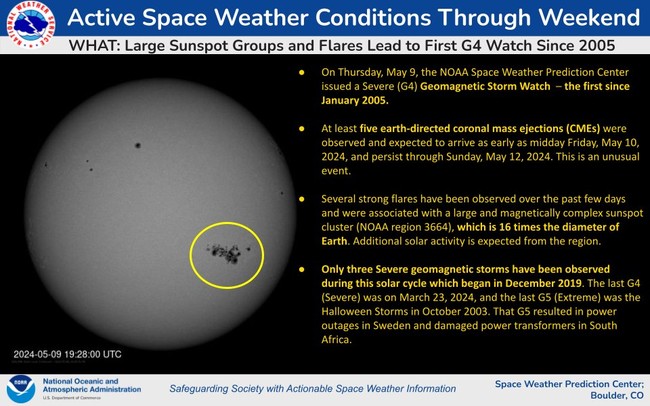After days of observing “large sunspot groups” and “several strong flares, NOAA’s Space Weather Prediction Center issued a G4 Severe Geomagnetic Storm Watch for Friday, May 10, through Sunday, May 12.

A graphic circulating with information about the watch said, in part:
At least five earth-directed coronal mass ejections were observed and expected to arrive as early as midday Friday, May 10, 2024, and persist through Sunday, May 12, 2024. This is an unusual event.
Several strong flares have been observed over the past few days and were associated with a large and magnetically complex sunspot cluster (NOAA region 3664), which is 16 times the diameter of Earth.
In a media advisory, the agency explained what coronal mass ejections (CMEs) are, and how they can disrupt our technology-dependent lives.
CMEs are explosions of plasma and magnetic fields from the sun’s corona. They cause geomagnetic storms when they are directed at Earth.
Geomagnetic storms can impact infrastructure in near-Earth orbit and on Earth’s surface, potentially disrupting communications, the electric power grid, navigation, radio and satellite operations. SWPC has notified the operators of these systems so they can take protective action.
Geomagnetic storms can also trigger spectacular displays of aurora on Earth. A severe geomagnetic storm includes the potential for aurora to be seen as far south as Alabama and Northern California.
While geomagnetic storms have the potential to severely disrupt life on earth, particularly by damaging or knocking out portions of the electric grid, NOAA says that the vast majority of G5 storms (the highest level) “will not cause catastrophic damage to the electric grid” and noted that “On average, the Earth is impacted by such storms about four times during every 11-year solar cycle, so many large storms have impacted the planet since the Carrington Storm with much less signification impact.”
Still, if one wants to be prepared, the steps are much the same as those families can/should take to prepare for natural disasters.



